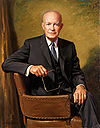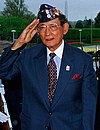The United States Military Academy (USMA) is an undergraduate college in West Point, New York with the mission of educating and commissioning officers for the United States Army. The academy was founded in 1802 and is the oldest of the United States' five service academies.[1][2] It is also referred to as West Point (the name of the military base that the academy is a part of).[1] The academy graduated its first cadet, Joseph Gardner Swift, in October 1802. Sports media refer to the academy as "Army" and the students as "Cadets"; this usage is officially endorsed.[3] The football team is also known as "The Black Knights of the Hudson" and "The Black Knights".[3][4][5] A small number of graduates each year choose the option of cross-commissioning into the United States Air Force, United States Navy, or the United States Marine Corps. Before the founding of the United States Air Force Academy in 1955, the academy was a major source of officers for the Air Force and its predecessors. Most cadets are admitted through the congressional appointment system.[6][7] The curriculum emphasizes the sciences and engineering fields.[8][9]
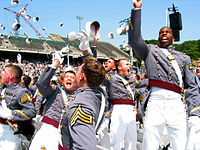

The list is drawn from graduates, non-graduate former cadets, current cadets, and faculty of the Military Academy. Notable graduates include 2 American Presidents, 4 additional heads of state, 20 astronauts, 76 Medal of Honor recipients (more than any other service academy or undergraduate institution),[10] 70 Rhodes Scholars,[11] and 3 Heisman Trophy winners. Among American universities, the academy is fourth on the list of total winners for Rhodes Scholarships, seventh for Marshall Scholarships and fourth on the list of Hertz Fellowships.[12]
Academicians
- "Class year" refers to the alumni's class year, which usually is the same year they graduated. However, in times of war, classes often graduate early. For example, there were two classes in 1943 – January 1943 and June 1943.
Academics
- Note: "Class year" refers to the alumni's class year, which usually is the same year they graduated. However, in times of war, classes often graduate early.
       |
Superintendents of the United States Military Academy
| 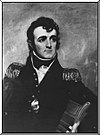   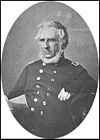 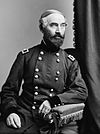 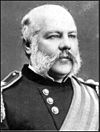 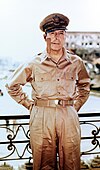 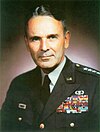  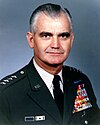 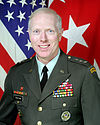   |
Commandants of the United States Military Academy
|      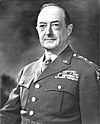  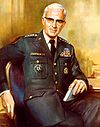 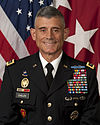 |
Top-ranking graduates
Astronauts
- Note: "Class year" refers to the alumni's class year, which usually is the same year they graduated. However, in times of war, classes often graduate early.
| 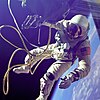  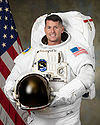 |
Authors
This a new list that requires significant work to be remotely complete. New, accurate, contributions are welcome and needed.
|
Businesspeople
- Henry A. du Pont, class of 1861, President and general manager of Wilmington & Western Railroad (1879–1899)
- Robert E. Wood, class of 1900, chairman and CEO of Sears, Roebuck (1939–1954); responsible for shifting the company's focus from a mail-order catalog company to a department store retailer; started AllState Insurance as a subsidiary of Sears; served as the Quartermaster of the Army in World War I and as chief quartermaster during the construction of the Panama Canal
- William T. Seawell, class of 1941, chairman and CEO of Pan Am Airways (1971–1981)
- Robert F. McDermott, class of 1943, former chairman and CEO of United Services Automobile Association (USAA)
- John F. Donahue, class of 1946, founder and Chairman of Federated Investors ($400 billion asset management firm)
- Frank Borman, class of 1950, President of Eastern Airlines (1975–1986)
- Walter F. Ulmer, class of 1952, President and CEO of Center for Creative Leadership (1985–1994)
- Rand Araskog, class of 1953, President, chairman, and CEO of ITT Communications
- Dana G. Mead, class of 1957, chairman and CEO of Tenneco (1994–1999), Chairman of MIT Corporation (since 2003)
- Pete Dawkins, class of 1959, former chairman and CEO of Primerica Financial Services, Vice-chairman and EVP of Travelers Insurance, Vice Chairman of Bain and Company, Vice Chairman of Citi Global Wealth Management, currently Senior Partner at Flintlock Capital
- Fred Malek, class of 1959, founder and Chairman of Thayer Capital Partners, Chairman of Northwest Airlines
- Frank J. Caufield, co-founder of venture capital firm Kleiner Perkins Caufield & Byers
- Albert Dunlap, class of 1960, CEO of Scott Paper and Sunbeam
- Jim Kimsey, class of 1962, chairman and co-founder of AOL
- Daniel W. Christman, class of 1965, Superintendent of USMA, 1996–2001; Chairman of Ultralife Corporation, SVP of International Affairs for US Chamber of Commerce (since 2003)
- John B. Ritch III, class of 1965, chairman and co-founder of Calivita International (since 1992)
- William P. Foley II, class of 1967, former CEO and current Chairman of Fidelity National Information Services
- Marshall Larsen, class of 1970, chairman and CEO of Goodrich, Corporation (since 2003)
- Bob McDonald, class of 1975, CEO of Procter & Gamble
- Ken Hicks, class of 1974, President and CEO of Foot Locker, former President of JCPenney
- William Albrecht, class of 1974, President of Occidental Oil and Gas
- Vincent Viola, class of 1977, former Chairman of NYMEX (2001–2004), CEO of VirtuFinancial, owner and member of Chairman's Council of the New Jersey Nets
- Keith McLoughlin, class of 1978, President and CEO of Electrolux
- Alex Gorsky, class of 1982, CEO of Johnson & Johnson
- Mark Green, class of 1986, founder and former CEO of Align MD
- Anthony J. Guzzi, class of 1986, President and CEO of EMCOR Group, Inc., the world's largest specialty construction, facilities services, energy infrastructure provider and a Fortune 500 company
- David McCormick, class of 1987, CEO of Bridgewater Associates, one of the world's largest hedge funds, from 2020 to 2022. Named president of FreeMarkets in 2001 and was named chief executive officer in 2002; he successfully sold FreeMarkets to Ariba in 2004 for approximately $500 million.
- Mark Clouse, class of 1990, President and CEO of Campbell Soup Company
- Anthony Noto, class of 1991, former CFO and COO of Twitter and current CEO of SoFi
- John Ham, class of 2000, Ustream Founder, CEO and Chairman
- Brad Hunstable, class of 2001, founder and President of Ustream.TV
Engineers
|  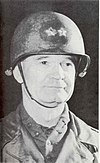 |
Government
Heads of state
Directors of the Central Intelligence Agency
- Hoyt Vandenberg, class of 1923, DCI 10 June 1946 – 1 May 1947
- David Petraeus, class of 1974, DCIA 6 September 2011 – 9 November 2012
- Mike Pompeo, class of 1986, DCIA 23 January 2017 – 26 April 2018 (became United States Secretary of State)
Cabinet members
- Andrew J. Donelson, class of 1820, President's Secretary (1829–1837)
- Jefferson Davis, class of 1828, United States Secretary of War (1853–1857)
- Montgomery Blair, class of 1835, United States Postmaster General (1861–1864)
- William Tecumseh Sherman, class of 1840, United States Secretary of War (1869)
- Gustavus Woodson Smith, class of 1842, Confederate States Secretary of War (1862)
- John Schofield, class of 1853, United States Secretary of War (1868–1869)
- Marshall Carter, class of 1931, Deputy Director of Central Intelligence (1962–1965) and Director of the National Security Agency (1965–1969)
- Rafael M. Ileto, class of 1943, Philippine Secretary of National Defense (1986–1988)
- Brent Scowcroft, class of 1947, National Security Advisor (1974–1977, 1989–1993)
- Alexander Haig, class of 1947, United States Secretary of State (1981–1982)
- Fidel V. Ramos, class of 1950, Philippines Secretary of National Defense (1988–1991)
- John Block, class of 1957, United States Secretary of Agriculture (1981–1986)
- Jim Nicholson, class of 1961, United States Secretary of Veterans Affairs (2005–2007)
- Barry McCaffrey, class of 1964, US Drug Czar (1996–2001)
- Eric K. Shinseki, class of 1965, United States Secretary of Veterans Affairs (2009–2014)
- James Peake, class of 1966, United States Secretary of Veterans Affairs (2007–2009)
- Robert Alan McDonald, class of 1975, United States Secretary of Veterans Affairs (2014–2017)[155]
- Mike Pompeo, class of 1986, United States Secretary of State (2018–2021), former Director of the Central Intelligence Agency (2017–2018)
- Mark Esper, class of 1986, 27th United States Secretary of Defense (2019–2020), former 23rd United States Secretary of the Army (2017–2019)
- Lloyd Austin, class of 1975, 28th United States Secretary of Defense (2021–present)
Secretaries of the Army
- Howard Hollis Callaway, class of 1949, 11th United States Secretary of the Army (1973-1975)
- Louis Caldera, class of 1978, 17th United States Secretary of the Army (1998-2001)
- Thomas E. White, class of 1967, 18th United States Secretary of the Army (2001-2004)
- Mark Esper, class of 1986, 23rd United States Secretary of the Army (2017–2019)
Ambassadors
| 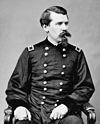 |
- Andrew J. Donelson, class of 1820, Chargé d'affaires of the United States to the Republic of Texas (1845), U.S. Minister to Prussia (1846–49), U.S. vice presidential candidate (1856)
- Rufus King, class of 1833, U.S. Minister to the Papal States (1863–1867)
- William Woods Averell, class of 1855, U.S. Consul General to British North America (1866–1869)
- Hugh Judson Kilpatrick, class of 1856, U.S. Minister to Chile, 1866–70, 1881
- Frederick Dent Grant, class of 1871, U.S. Minister to Austro-Hungarian Empire (1890–1893)
- James Maurice Gavin, class of 1929, U.S. Ambassador to France (1961–62)
- John Eisenhower, class of 1944, U.S. Ambassador to Belgium (1969–1971)
- David Manker Abshire, class of 1951, U.S. Ambassador to NATO (1983–1987)
- John Galvin, class of 1954, U.S. Ambassador to Bosnian Peace Negotiations[162]
- Jim Nicholson, class of 1961, U.S. Ambassador to the Vatican (2001–2005)
- John B. Ritch III, class of 1965, U.S. Ambassador to United Nations International Organizations in Vienna (1993–2001)
- Robert M. Kimmitt, class of 1969, U.S. Ambassador to Germany (1991–1993)
- William B. Taylor Jr., class of 1969, U.S. Ambassador to Ukraine (2006–2009, 2019–2020)
- Karl Eikenberry, class of 1973, U.S. Ambassador to Afghanistan (2009–2011)
- Matthew Klimow, class of 1974, U.S. Ambassador to Turkmenistan (2019–present), acting State Department Inspector General (2020)
Governors (civil)
|   |
- Robert Francis Withers Allston, class of 1821, Governor of South Carolina (1856–58)
- David Wallace, class of 1821, Governor of Indiana (1837–1840)
- Robert Milligan McLane, class of 1837, Governor of Maryland (1884–85)
- Isaac Ingalls Stevens, class of 1839, Governor of Washington Territory (1853–1857)
- George Stoneman, class of 1846, Governor of California (1883–1887)
- George B. McClellan, class of 1846, Governor of New Jersey (1878–81)
- Ambrose Burnside, class of 1847, Governor of Rhode Island (1866–69)
- Francis Redding Tillou Nicholls, class of 1855, Governor of Louisiana (1877–80, 88–92)
- William H. Upham, class of 1866, Governor of Wisconsin (1895–1897)
- Alexander Oswald Brodie, class of 1870, Governor of Arizona Territory (1902–05)
- Charles H. Martin, class of 1887, Governor of Oregon (1935–39)
- Chester Harding, class of 1889, Governor of Panama Canal Zone (1917–21)
- Jay Johnson Morrow, class of 1891, Governor of Panama Canal Zone (1921–24)
- Meriwether L. Walker, class of 1893, Governor of Panama Canal Zone (1924–28)
- Harry Burgess, class of 1895, Governor of Panama Canal Zone (1928–32)
- Clarence S. Ridley, class of 1905, Governor of Panama Canal Zone (1936–40)
- Glen E. Edgerton, class of 1908, Governor of Panama Canal Zone (1940–44)
- Joseph C. Mehaffey, class of 1911, Governor of Panama Canal Zone (1944–48)
- Francis K. Newcomer, class of 1913, Governor of Panama Canal Zone (1948–52)
- John S. Seybold, class of 1920, Governor of Panama Canal Zone (1952–56)
- William E. Potter, class of 1933, Governor of Panama Canal Zone (1956–60)
- William A. Carter, class of 1930, Governor of Panama Canal Zone (1960–62)
- Robert John Fleming, class of 1928, Governor of Panama Canal Zone (1962–67)
- David Stuart Parker, class of 1940, Governor of Panama Canal Zone (1971–75)
- Harold Parfitt, class of 1943, Governor of Panama Canal Zone (1975–79)
- Warren E. Hearnes, class of 1946, Governor of Missouri (1965–1973)
- Dave Heineman, class of 1970, Governor of Nebraska (2005–2015)
- John Bel Edwards, class of 1988, Governor of Louisiana (2016–present)
Governors (military)
| 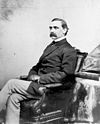 |
- Thomas Childs, class of 1814, military governor of Puebla, Mexico
- John H. Martindale, class of 1835, military Governor of Washington, D.C.
- Rufus Saxton, class of 1849, military governor of the Department of the South
- Fitzhugh Lee, class of 1856, military governor of Havana, Cuba
- Philip Sheridan, class of 1853, military governor of the Fifth Military District
- Douglas MacArthur, class of 1903, military governor of Japan
- George S. Patton, class of 1909, military governor of Bavaria
- Joseph T. McNarney, class of 1915, military governor of U.S. Occupation Zone, Germany
- Matthew Ridgway, class of 1917, military governor of Japan
- Lucius D. Clay, class of 1918, military Governor in West Germany noted for Berlin Airlift
Legislators
| 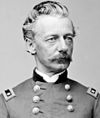  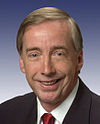 |
- Daniel Azro Ashley Buck, class of 1808, U.S. Representative (1823–1825, 1827–1829), Vermont
- Daniel Tunern, class of 1814, U.S. Representative, North Carolina (1827–1829)
- James Monroe, class of 1815, U.S. Representative (1839–1841), New York
- George Wurtz Hughes, class of 1827, U.S. Representative (1859–1861), Maryland
- Jefferson Davis, class of 1828, U.S. Representative (1845–1846) and Senator (1847–1853, elected but not seated 1875), Mississippi
- Alexander C.M. Pennington, class of 1828, represented New Jersey's 5th congressional district in the United States House of Representatives 1853–1857[176]
- Joseph E. Johnston, class of 1829, U.S. Representative, Virginia
- Henry Bell Van Rensselaer, class of 1831, U.S. Representative, New York
- Robert Milligan McLane, class of 1837, U.S. Representative, Maryland
- John B. S. Todd, class of 1837, U.S. Congressman, Dakota Territory (1861–1863, 1864–1865)
- James Madison Leach, class of 1838, U.S. Representative, North Carolina
- Isaac Ingalls Stevens, class of 1839, U.S. Representative, Washington Territory
- Egbert Ludoricus Viele, class of 1847, U.S. Representative, New York
- Ambrose Burnside, class of 1847, U.S. Senator, Rhode Island (1875–1881)
- Henry Warner Slocum, class of 1852, U.S. Representative, New York (1869–1873, 1883–1884)
- Henry A. du Pont, class of 1861, U.S. Senator, Delaware (1895–1896, 1906–1917)
- Joseph Wheeler, class of 1859, U.S. Representative, Alabama (1881–1882, 1883, 1885–1900)
- Frank Obadiah Briggs, class of 1872, U.S. Senator, New Jersey
- Jesse Matlack Baker, class of 1873, Pennsylvania State Representative (1889-1892) and State Senator (1893-1897)
- Lawrence D. Tyson, class of 1883, U.S. Senator, Tennessee (1925–1929)
- Bertram Tracy Clayton, class of 1886, U.S. Representative, New York (1899–1901)
- Charles Henry Martin, class of 1887, U.S. Representative, Oregon
- Butler Ames, class of 1894, U.S. Representative, Massachusetts
- Frank Kowalski, class of 1930, U.S. Representative from Connecticut
- Nile Soik, class of 1945, member of the Wisconsin State Legislature[177]
- Howard Hollis Callaway, class of 1949, U.S. Representative, Georgia (1965-1967)
- John Michael Murphy, class of 1950, U.S. Representative, New York (1963-1981)
- Adam Benjamin Jr., class of 1958, U.S. Representative, Indiana (1977–82)
- Jack Reed, class of 1971, U.S. Representative (1991–1997), U.S. Senator (1997- ), Rhode Island
- John Shimkus, class of 1980, U.S. Representative, Illinois (1997– 2021)
- Geoff Davis, class of 1981, U.S. Representative, Kentucky (2004– 2012)
- Mike Pompeo, class of 1986, U.S. Representative, Kansas (2011–2017)
- Mark Green, class of 1986, U.S. Representative, Tennessee (2019– )
- Brett Guthrie, class of 1987, U.S. Representative, Kentucky (2009– )
- Warren Davidson, class of 1995, U.S. Representative, Ohio (2016– )
- Steve Watkins, class of 1999, U.S. Representative, Kansas (2018– )
- Pat Ryan, class of 2004, U.S. Representative, New York (2022– )
- John James, class of 2004, U.S. Representative, Michigan (2023–)
- Wesley Hunt, class of 2004, U.S. Representative, Texas (2023–)
Mayors
|
- William Lewis Cabell, class of 1850, Mayor of Dallas, Texas (1874–76, 1877–79, 1883–85)
- Frank Fischl, class of 1951, Mayor of Allentown, Pennsylvania (1978–1982)[179]
- Robert M. Isaac, class of 1951, Mayor of Colorado Springs, Colorado (1979–1997)
- Matthew Collier, class of 1979, Mayor of Flint, Michigan (1988–1992)
- Maria Vedder Lowe, class of 1998, Mayor of St. Pete Beach, Florida (2014–2016)[180]
- Adrian Perkins, class of 2008, Mayor of Shreveport, Louisiana (2018–2022)
Jurists
- John Archibald Campbell, ex-class of 1830, Associate Justice of the Supreme Court of the United States (1853-1861)
- Montgomery Blair, class of 1835, attorney for Dred Scott in landmark 1857 Supreme Court case Dred Scott v. Sandford, United States Postmaster General (1861–1864)
- Francis Redding Tillou Nicholls, class of 1855, Chief Justice Louisiana Supreme Court (1892–1911)
- Richard Whitehead Young, class of 1882, Philippines Supreme Court Justice (1899–1901)
- Richard D. Cudahy, class of 1948, Judge on the United States Court of Appeals for the Seventh Circuit (1979-2015)
- Malcolm Jones Howard, class of 1962, Judge, United States District Court Eastern District of North Carolina (1987–2005)
- Mike Bowers, class of 1963, Georgia's longest-serving Attorney General (1981–1997)
- Eugene R. Sullivan, class of 1964, Chief Judge United States Court of Appeals for the Armed Forces (1986–2002)
- Rhesa Barksdale, class of 1966, U.S. Court of Appeals for the Fifth Circuit (1990–2009)
- Roy Moore, class of 1969, Chief Justice Alabama Supreme Court (2001–2003, 2013–2017)
- Bruce E. Kasold, class of 1973, Judge on the United States Court of Appeals for Veterans Claims (2003-2016)
Law enforcement and intelligence figures
- Fitz John Porter, class of 1845, New York City Police Commissioner
- William Farrar Smith, class of 1845, New York City Police Commissioner
- Frederick Dent Grant, class of 1871, New York City Police Commissioner
- Douglas I. McKay, class of 1905, New York City Police Commissioner
- Norman Schwarzkopf Sr., class of 1917
- Alva Revista Fitch, class of 1930
- Barry McCaffrey class of 1964, Drug Czar during Clinton Administration
- Donald B. Smith class of 1969, New York State Sheriff Association President, Putnam County Sheriff 2002–2018
- Keith B. Alexander class of 1974, Head of the National Security Agency, General – Commander of Cyber Command
- Lon Horiuchi, class of 1976
Literary figures and actors
|
- Henry Martyn Robert, class of 1857, author of Robert's Rules of Order
- William James Roe, class of 1867, author of satirical and metaphysical works, poet and artist
- John Wilson Ruckman, class of 1883, first editor of Journal of U.S. Artillery, author of numerous technical articles on gunnery
- Herbert H. Sargent, class of 1883, author of Napoleon Bonaparte's First Campaign, The Campaign of Marengo and The Campaign of Santiago de Cuba
- Cornelis DeWitt Willcox, class of 1885
- Col. Mark M. Boatner III, class of June 1943, author of Civil War Dictionary, Encyclopedia of the American Revolution
- Hal Moore, class of 1945, author of We Were Soldiers Once...And Young
- James Salter, class of 1945, prolific author, selected to the Academy of Arts and Letters
- Bill McWilliams, class of 1955, author of A Return To Glory
- Gus Lee, ex-class of 1966, honorary member of the class of 1970, author of China Boy, Chasing Hepburn
- Lucian Truscott IV, class of 1969, journalist and author of Dress Grey
- Brian Haig, class of 1975, novelist
- James Carafano, class of 1977, author of Winning the Long War
- Mark Valley, class of 1987, TV and movie actor
- Col. Gregory D. Gadson, class of 1989, movie actor
- Paula Broadwell, class of 1995, author
Military figures
Medal of Honor recipients
Civil War
| 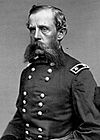 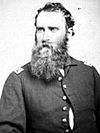 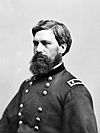 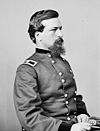  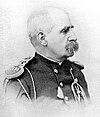 |
Indian Wars
|      |
Spanish–American War
| 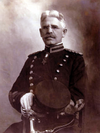 |
Philippine–American War
|  |
Boxer Rebellion
|
Mexican Campaign (Veracruz)
| 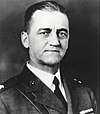 |
World War I
|
World War II
| 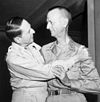 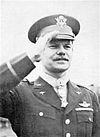 |
Korea
|
Vietnam
|   |
Mexican–American War combatants
| 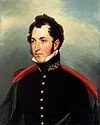 |
American Civil War combatants
Confederate States Army generals
| 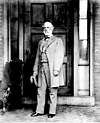   |
Union Army generals
|   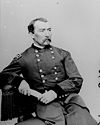 |
Indian Wars combatants and Buffalo Soldiers
|
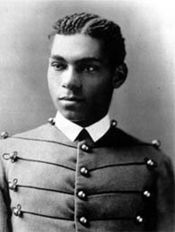
- John Hanks Alexander, class of 1887
- Walker Keith Armistead, class of 1803
- John W. Barlow, class of 1861
- John T. Barnett, class of 1878
- Robert C. Buchanan, class of 1830
- Edward Canby, class of 1839
- Elias Chandler, class of 1880
- Philip St. George Cooke, class of 1827
- George Crook, class of 1852
- George Armstrong Custer, class of 1861
- John Wynn Davidson, class of 1845
- Henry Ossian Flipper, class of 1877
- James W. Forsyth, class of 1856
- Robert S. Garnett, class of 1841
- John Gibbon, class of 1847
- Oliver O. Howard, class of 1854
- Robert Lee Howze, class of 1888
- Charles King, class of 1866
- Thomas J. Lewis, class of 1875
- Gustavus Loomis, class of 1811
- Ranald S. Mackenzie, class of 1862
- Randolph B. Marcy, class of 1832
- Wesley Merritt, class of 1860
- George H. Morgan, class of 1880
- Edward Ord, class of 1839
- John J. Pershing, class of 1886
- John Pope (military officer), class of 1842
- Marcus Reno, class of 1857
- William Tecumseh Sherman, class of 1840
- Philip Sheridan, class of 1853
- Samuel D. Sturgis, class of 1846
- George Wright, class of 1822
- Charles Young, class of 1889
Spanish–American War and Philippine Insurrection combatants
|
- Stanley Dunbar Embick, class of 1899
- Frederick Dent Grant, class of 1871
- William G. Haan, class of 1889
- Hamilton S. Hawkins, class of 1855
- Guy Henry, class of 1898
- Lucius Roy Holbrook, class of 1896
- Willard Ames Holbrook, class of 1885
- Robert Lee Howze, class of 1888
- Richard L. Hoxie, class of 1868
- Jacob Ford Kent, class of 1861
- Charles King, class of 1866
- Fitzhugh Lee, class of 1856
- Manus MacCloskey, class of 1898
- Wesley Merritt, class of 1860
- Eben Swift, class of 1876
- Charles Symmonds, class of 1888
- Joseph Wheeler, class of 1859
- James H. Wilson, class of 1860
- John Moulder Wilson, class of 1860
Pancho Villa Expedition combatants
|
World War I combatants
| 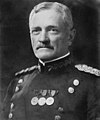 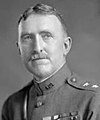  |
World War II combatants
|    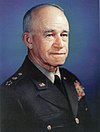 |
Korean War combatants
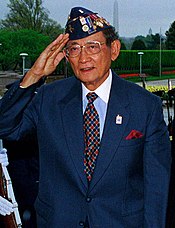
- Creighton Abrams, class of 1936, Corps Chief of Staff, Korean War. In 1980, the United States Army named its then-new main battle tank, the M1 Abrams, after him.
- Arnold W. Braswell, class of 1948
- Mark Wayne Clark, class of 1917
- J. Lawton Collins, class of 1917
- Lawrence Russell Dewey, class of 1924
- James Van Fleet, class of 1915
- Alexander Haig, class of 1947
- William M. Hoge, class of 1916
- Lyman Lemnitzer, class of 1920
- Douglas MacArthur, class of 1903
- Andrew P. O'Meara, class of 1930
- Ralph Puckett, class of 1949, Commander of 8th Army Ranger Company
- Fidel V. Ramos, class of 1950, Platoon leader of the 20th Battalion Combat Team, Philippine Expeditionary Forces to Korea
- Matthew Ridgway, class of 1917
- Davis C. Rohr, class of 1952
- Edward Rowny, class of 1941
- Maxwell D. Taylor, class of 1922
- Thomas J. H. Trapnell, class of 1927
- William H. Tunner, class of 1928
- Sam S. Walker, class of 1946
- Walton Walker, class of 1912
- Roderick Wetherill, class of 1940. later major general in the Vietnam War
Vietnam War combatants
- Creighton Abrams, class of 1936, commanded the U.S. Army Military Assistance Command, Vietnam (1968–1972)
- Alfred Judson Force Moody, class of 1941, Brigadier General, died of a heart attack one week after arriving in Vietnam
- George W. Casey Sr., class of 1945, Major General, killed in a helicopter crash in Vietnam
- Anderson W. Atkinson, class of 1946
- Richard J. Tallman, class of 1949, Brigadier General; killed by North Vietnamese artillery fire, last US Army General to die in South Vietnam. [284] [285]
- Peter J. Boylan, class of 1961
- Wesley Clark, class of 1966
- Harry Griffith Cramer Jr., class of 1946
- Eugene Peyton Deatrick, class of 1946
- Jack K. Farris, class of 1957
- Alexander Haig, class of 1947
- Paul D. Harkins, class of 1929
- Harold Keith Johnson, class of 1933
- Nicholas S. H. Krawciw, class of 1959
- Barry McCaffrey, class of 1964
- Montgomery Meigs, class of 1967
- Hal Moore, class of 1945, commanded 1st Battalion, 7th Cavalry Regiment in the Ia Drang Valley (1965)
- Joseph J. Nazzaro, class of 1936
- Robin Olds, class of 1943
- George Patton IV, class of 1946
- Ralph Puckett, class of 1949, Commander 2d Battalion, 502d Infantry (Airborne), 101st Airborne Division
- Fidel V. Ramos, class of 1950, Chief of Staff of the Philippine Military Contingent and Civil Action Group to Vietnam (1965–1968)
- Davis C. Rohr, class of 1952
- Hoyt S. Vandenberg Jr., class of 1951
- Sam S. Walker, class of 1946
- William Westmoreland
Gulf War combatants
|   |
War on Terror
Participants
|
Afghanistan combatants
|
Iraq combatants
| 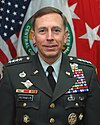  |
Supreme Allied Commanders of NATO
- Dwight Eisenhower, class of 1915
- Lyman Lemnitzer, class of 1922
- Andrew Goodpaster, class of 1939
- Bernard W. Rogers, class of 1943
- Alexander Haig, class of 1947
- John Galvin, class of 1954
- George Joulwan, class of 1961
- Wesley Clark, class of 1966
- Curtis M. Scaparrotti, class of 1978
Chairmen of the Joint Chiefs of Staff
- Omar N. Bradley, class of 1915, CJCS, 1949–1953
- Nathan F. Twining, class of 1919, CJCS, 1957–1960
- Lyman L. Lemnitzer, class of 1920, CJCS, 1960–1962
- Maxwell D. Taylor, class of 1922, CJCS, 1962–1964
- Earle G. Wheeler, class of 1932, CJCS, 1964–1970
- George Scratchley Brown, U.S. Air Force, class of 1941, CJCS, 1974–1978
- Martin E. Dempsey, class of 1974, CJCS, 2011–2015
Army Chiefs of Staff/Commanders of the Army
- George B. McClellan, class of 1846, Commanding General of the Army (1861–1862)
- Henry Wager Halleck, class of 1839, Commanding General of the Army (1862–1864)
- Ulysses S. Grant, class of 1843, Commanding General of the Army (1864–1869)
- William Tecumseh Sherman, class of 1840, Commanding General of the Army (1869–1883)
- Philip Sheridan, class of 1853, Commanding General of the Army (1883–1888)
- John Schofield, class of 1853, Commanding General of the Army (1888–1895)
- J. Franklin Bell, class of 1878, 4th U.S. Army Chief of Staff (1906–1910)
- Hugh L. Scott, class of 1876, 7th U.S. Army Chief of Staff (1914–1917)
- Tasker H. Bliss, class of 1875, 8th U.S. Army Chief of Staff (1917–1918)
- Peyton C. March, class of 1888, 9th U.S. Army Chief of Staff (1918–1921)
- John Pershing, class of 1886, 10th U.S. Army Chief of Staff (1921–1924)
- John L. Hines, class of 1891, 11th U.S. Army Chief of Staff (1924–1926)
- Charles Pelot Summerall, class of 1892, 12th U.S. Army Chief of Staff (1926–1930)
- Douglas MacArthur, class of 1903, 13th U.S. Army Chief of Staff (1930–1935)
- Malin Craig, class of 1898, 14th U.S. Army Chief of Staff (1935–1939)
- Dwight D. Eisenhower, class of 1915, 16th U.S. Army Chief of Staff (1945–1948)
- Omar Bradley, class of 1915, 17th U.S. Army Chief of Staff (1948–1949)
- J. Lawton Collins, class of 1917, 18th U.S. Army Chief of Staff (1949–1953)
- Matthew Ridgway, class of 1917, 19th U.S. Army Chief of Staff (1953–1955)
- Maxwell D. Taylor, class of 1922, 20th U.S. Army Chief of Staff (1955–1959)
- Lyman Lemnitzer, class of 1920, 21st U.S. Army Chief of Staff (1959–1960)
- Earle Wheeler, class of 1932, 23rd U.S. Army Chief of Staff (1962–1964)
- Harold Keith Johnson, class of 1933, 24th U.S. Army Chief of Staff (1964–1968)
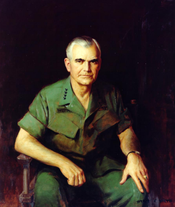
- William Westmoreland, class of 1936, 25th U.S. Army Chief of Staff (1968–1972)
- Bruce Palmer Jr., class of 1936, Acting U.S. Army Chief of Staff (1972)
- Creighton Abrams, class of 1936, 26th U.S. Army Chief of Staff (1972–1974)
- Bernard W. Rogers, class of 1943, 28th U.S. Army Chief of Staff (1976–1979)
- Edward C. Meyer, class of 1951, 29th U.S. Army Chief of Staff (1979–1983)
- John Wickham, class of 1950, 30th U.S. Army Chief of Staff (1983–1987)
- Carl E. Vuono, class of 1957, 31st U.S. Army Chief of Staff (1987–1991)
- Dennis Reimer, class of 1962, 33rd U.S. Army Chief of Staff (1995–1999)
- Eric Shinseki, class of 1965, 34th U.S. Army Chief of Staff (1999–2003)
- Martin E. Dempsey, class of 1974, 37th U.S. Army Chief of Staff (2011)
- Raymond T. Odierno, class of 1976, 38th U.S. Army Chief of Staff (2011–2015)
- James C. McConville, class of 1981, 40th US. Army Chief of Staff (2019–2023)
- Randy A. George, class of 1988, 41st U.S. Army Chief of Staff (2023-present)
Chiefs of the National Guard Bureau / Chiefs of the Militia Bureau
- Erasmus M. Weaver Jr., class of 1875, 1st Chief of the Militia Bureau (1908-1911)
- Robert K. Evans, class of 1875, 2nd Chief of the Militia Bureau (1911-1912)
- Albert Leopold Mills, class of 1879, 3rd Chief of the Militia Bureau (1912-1916), Medal of Honor recipient in the Spanish-American War (Battle of San Juan Hill)
- George W. McIver, class of 1882, acting Chief of the Militia Bureau (September–October 1916)
- William Abram Mann, class of 1875, 4th Chief of the Militia Bureau (1916-1917)
- Jesse McI. Carter, class of 1886, 5th Chief of the Militia Bureau (1917-1918 and 1919-1921)
- John W. Heavey, class of 1891, acting Chief of the Militia Bureau (1918-1919)
- Donald W. McGowan, attended 1919-1922, 16th Chief of the National Guard Bureau (1959-1963)
- Raymond F. Rees, class of 1966, acting Chief of the National Guard Bureau (August–September 1994 and 2002-2003)
- Daniel R. Hokanson, class of 1986, 29th Chief of the National Guard Bureau (2020–present)
Air Force Chiefs of Staff
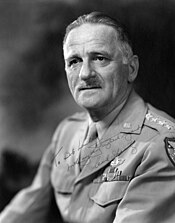
- Carl Spaatz, class of 1914, 1st USAF Chief of Staff (1947–1948)
- Nathan Farragut Twining, class of 1918, 3rd USAF Chief of Staff (1953–1957)
- Thomas D. White, class of 1920, 4th USAF Chief of Staff (1957–1961)
- John P. McConnell, class of 1932, 6th USAF Chief of Staff (1965–1969)
- John Dale Ryan, class of 1938, 7th USAF Chief of Staff (1969–1973)
- George Scratchley Brown, class of 1941, USAF Chief of Staff (1973–1974)
- Lew Allen, class of 1946, 10th USAF Chief of Staff (1978–1982)
- Charles A. Gabriel, class of 1950, 11th USAF Chief of Staff (1982–1986)
- Michael Dugan, class of 1958, 13th USAF Chief of Staff (1990)
Chief of Staff of non-American armed forces
- Douglas MacArthur, class of 1903, Field Marshal of the Armed Forces of the Philippines (1935–1946)
- Fidel V. Ramos, class of 1950, Chief of Staff of the Armed Forces of the Philippines (1986–1988)
Presidential and Congressional awardees
Presidential Medal of Freedom recipients
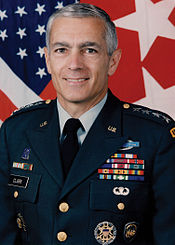
- Brent Scowcroft, class of 1947, medal awarded in 1991
- Buzz Aldrin
- Michael Collins
- Omar Bradley
- Wesley Clark
- Norman Schwarzkopf Jr.
- Earl Blaik
Congressional Gold Medal recipients
Congressional Space Medal of Honor recipients
Religious Figures
- Michael J. Almeyda, class of 2005, Pastor at Refuge Ranch Ministries
Scientists, inventors, and physicians
- Benjamin Alvord, class of 1833, mathematician
- Seth Barton, class of 1849 (USA and CSA), chemist
- George Bomford, class of 1805, inventor of ordnance and explosives; standardized army usage as Chief of the Ordnance Department
- John James Abert, class of 1811, head topographer for the U.S. Army; his officers mapped the American West under his supervision
- Benjamin Bonneville, class of 1815, organized expedition that explored the Great Salt Lake, crossed the Sierras, found the headwaters of the Yellowstone and discovered the Humboldt River
- George Washington Whistler, class of 1819, invented contour lines on maps, father of James McNeill Whistler, the artist, husband of "Whistler's Mother"
- Robert Parker Parrott, class of 1824, invented the Parrott rifle used extensively during the American Civil War
- Ormsby M. Mitchel, class of 1825, astronomer
- Henry du Pont, class of 1833, improved the production of gunpowder, chemicals industry pioneer. Father of Henry A. du Pont, class of 1861, and Medal of Honor recipient
- Thomas Jackson Rodman, class of 1841, inventor of the Rodman gun
- William W. Averell, class of 1855, inventor of asphalt
- John Wilson Ruckman, class of 1883, inventor of artillery devices critical in World War I
- George O. Squier, class of 1887, developer of Muzak, early radio engineer
- Leslie Groves, class of 1918, chief engineer for the Manhattan Project and the Pentagon
- Edward A. Murphy Jr., class of 1940, credited with the invention of Murphy's Law
- Peter Huybers, class of 1996, MacArthur Foundation Grant awardee ("Genius Grant"), planetary and climate scientist, currently a professor at Harvard
- John T. Thompson, class of 1882, inventor of the Thompson submachine gun
- Edward S. Holden, class of 1870, astronomer, librarian at West Point, 5th president of the University of California, Founder, Lick observatory
- Isaac Newton Lewis, class of 1884, inventor of the Lewis gun
Graduates Involved with the Manhattan Project
|    |
Sportspeople
Athletes
|  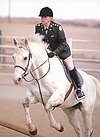   |
Coaches
|   |
Television and movie figures
- James Salter, class of 1945, screenwriter
- Rod Lurie, class of 1984, director, screenwriter
- Mark Valley, class of 1987, actor
- Kelly Perdew, class of 1989, reality show winner, The Apprentice (2004)
- Greg Plitt, class of 2000, fitness supermodel and actor

Eponyms
- Ambrose Burnside, class of 1847 – sideburns
- Edward A. Murphy Jr., class of 1940 – Murphy's Law
- Henry Martyn Robert, class of 1857 – Robert's Rules of Order
- John T. Thompson, class of 1882 – inventor of the Thompson submachine gun, also known as the "Tommy Gun"
Places named for graduates
|
Graduates depicted on currency
- James B. McPherson, $2 bill, 1890s
- Pierre Gustave Toutant de Beauregard, $20 1863 State of Louisiana, Shreveport[364]
- Joseph K. Mansfield, $500 1873, 1875, 1878, 1880 United States (legal tender) notes[364]
- George Henry Thomas, $5 1890, 1891 Treasury or coin notes[364]
- Jefferson Davis, on Confederate notes
- George Meade, $1,000 1890, 1891 Treasury notes[364]
- Robert E. Lee, on U.S. coins, the 1937 Battle of Antietam Half Dollar Commemorative, and 1925 Stone Mountain Commemorative
- George McClellan, on 1937 Battle of Antietam Half Dollar Commemorative, 10¢ 1863 Searsport Bank, Maine, $1 1862 Chicopee Bank, Mass., $2 1861 Merchants Bank, N.J., $20 1862 Rutland County Bank, Vt.[364]
- Stonewall Jackson, on U.S. coin, the 1925 Stone Mountain Commemorative, $500 17 Feb. 1864, Confederate note[364]
- William T. Sherman, 15¢ fractional currency (proof notes), fourth issue, never circulated[364]
- Winfield Scott Hancock, $2 silver certificates 1880s-90s
- Ulysses S. Grant, class of 1843, on 1922 Grant Memorial Half Dollar and current U.S. $50 bill
- Philip Sheridan, $5 1896 silver certificate (back), $10 1890, 1891 Treasury or coin notes[364]
- Douglas MacArthur, 2500 piso gold, 1980, Philippines
- Dwight D. Eisenhower, $1 coin from 1971 to 1978, and 1990 Eisenhower Centennial Dollar
- Fidel V. Ramos, 2000 piso gold, 1996, Philippines
- $1 coin. Dwight D. Eisenhower, class of 1915 on obverse. The reverse is based on the Apollo 11 mission patch designed by Michael Collins, class of 1952.
- $50 bill. U.S. Grant, class of 1846
- $5 silver certificate with U.S. Grant and Phillip Sheridan
- U.S. Grant on a gold certificate
Graduates depicted on postage stamps
- Alden Partridge, class of 1806, appears on 11¢ Great Americans series stamp (1985)
- Sylvanus Thayer, class of 1808, appears on 9¢ Great Americans series stamp (1985)
- Jefferson Davis, class of 1828, appears on 6¢ Stone Mountain Memorial commemorative stamp (1970), 32¢ Civil War commemorative stamp (1995) and eight Confederate stamps
- Joseph E. Johnston, class of 1829, appears on 32¢ Civil War commemorative stamp (1995)
- Robert E. Lee, class of 1829, appears on 4¢ Army commemorative stamp (1937), 30¢ Liberty series stamp (1955 and 1957), 6¢ Stone Mountain Memorial stamp (1970), and 32¢ Civil War commemorative stamp (1995)
- Montgomery Blair, class of 1835, appears on 15¢ airmail stamp (1963) and on one Belgian stamp
- William Tecumseh Sherman, class of 1840, appears on 8¢ stamps (1893 and 1895), 3¢ Army commemorative stamp (1937), 32¢ Civil War commemorative stamp (1995), and on stamps from Guam, the Philippines, and Puerto Rico
- Ulysses S. Grant, class of 1843, appears on 5¢ stamps (1890, 1895, 1898), 4¢ stamp (1903), 8¢ stamp (1922), 3¢ Army commemorative stamp (1937), 18¢ Presidential series stamp (1938), 32¢ Civil War commemorative stamp (1995)
- Winfield Scott Hancock, class of 1844, appears on 32¢ Civil War commemorative stamp (1995)
- Stonewall Jackson, class of 1846, appears on 4¢ Army commemorative stamp (1937) and 6¢ Stone Mountain Memorial stamp (1970)
- Phillip Sheridan, class of 1853, appears on 3¢ Army commemorative stamp (1937)
- George Washington Goethals, class of 1880, appears on 3¢ Panama Canal commemorative stamp (1939) and on stamps issued for the Panama Canal Zone
- John J. Pershing, class of 1886, appears on 8¢ Liberty series stamp (1961) and on French stamps
- John L. Hines, class of 1891, appears on 33¢ Distinguished Soldiers commemorative stamp (2000)
- Douglas MacArthur, class of 1903, appears on 6¢ commemorative stamp (1971) and on stamps from Korea and the Philippines
- Joseph Stilwell, class of 1904, appears on 10¢ Distinguished Americans series stamp (2000)
- Henry H. Arnold, class of 1907, appears on 65¢ Great Americans series stamp (1988)
- George S. Patton Jr., class of 1909, appears on 3¢ commemorative stamp (1953) and on stamps from Belgium and Luxembourg.
- Omar Bradley, class of 1915, appears on 33¢ Distinguished Soldiers commemorative stamp (2000)
- Dwight D. Eisenhower, class of 1915, appears on 6¢ commemorative stamp (1969), 6¢ (1970) and 8¢ (1971) Prominent Americans series stamps, and on stamps of other countries
- Frank Borman, class of 1950, appears on ten stamps of Haiti, Hungary, and Senegal
- Fidel V. Ramos, class of 1950, appears on numerous Philippine Stamps since the 1990s
- Buzz Aldrin, class of 1951, appears on foreign stamps
Graduates selected as Time Magazine's "Person of the Year"
- Hugh S. Johnson, class of 1903, Man of the Year – 1933
- Dwight D. Eisenhower, class of 1915, Man of the Year – 1944, 1959
- General William Westmoreland, class of 1936, Man of the Year – 1965
- Col. Frank Borman, Apollo 8, Men of the Year – 1968 (shared honor with U.S. Naval Academy graduates James Lovell and Col. William Anders)
Other
- Maj. Gen. Samuel Ringgold, class of 1818; the "father of modern artillery"
- Maj. David Moniac, class of 1822
- Gen. Albert Sidney Johnston, class of 1826
- Lt. Gen. Leonidas Polk, class of 1827
- Gen. Jefferson Davis, class of 1828
- Gen. Robert E. Lee, class of 1829
- Maj. Gen. Whitfield Jack, class of 1928
- Gen. Joseph E. Johnston, class of 1829
- Maj. Gen. Francis Henney Smith, class of 1835
- Gen. George Meade, class of 1835
- Maj. Gen. Montgomery C. Meigs, class of 1836
- Gen. Braxton Bragg, class of 1837
- Lt. Gen. Jubal Early, class of 1837
- Maj. Gen. Joseph Hooker, class of 1837
- Gen. Pierre Gustave Toutant (P.G.T.) Beauregard, class of 1838
- Maj. Gen. E.R.S. Canby, class of 1839
- Maj. Gen. Henry Wager Halleck, class of 1839
- Lt. Gen. Richard S. Ewell, class of 1840
- Gen. William Tecumseh Sherman, class of 1840
- Col. Abner Doubleday, class of 1842
- Gen. James Longstreet, class of 1842
- Maj. Gen. William Rosecrans, class of 1842
- Gen. Ulysses S. Grant, class of 1843
- Lt. Gen. and Gov. Simon Bolivar Buckner, class of 1844
- Maj. Gen. Winfield Scott Hancock, class of 1844
- Gen. Stonewall Jackson, class of 1846
- Maj. Gen. George B. McClellan, class of 1846
- Maj. Gen. George Pickett, class of 1846; graduated last in the class
- Maj. Gen. Ambrose Burnside, class of 1847
- Lt. Gen. A. P. Hill, class of 1847
- Maj. Gen. John Buford, class of 1848
- Jerome Napoleon Bonaparte II, class of 1848
- Brig. Gen. Eugene Asa Carr, class of 1850
- Maj. Gen. Alvan Cullem Gillem, class of 1851
- Maj. Gen. George Crook, class of 1852
- Gen. John Bell Hood, class of 1853
- Lt. Gen John Schofield, class of 1853
- Gen. Philip Sheridan, class of 1853
- Maj. Gen. Oliver O. Howard, class of 1854
- Gen. Jeb Stuart, class of 1854
- Gen. George Armstrong Custer, class of June 1861; graduated last in class
- Brig. Gen. William Louis Marshall, class of 1868
- Gen. Tasker H. Bliss, class of 1875
- Brig. Gen. Willard Young class of 1875; first Mormon graduate and son of Brigham Young
- Maj. Gen. Hugh L. Scott, class of 1876
- Henry O. Flipper, class of 1877; first black American graduate
- Maj. Gen. J. Franklin Bell, class of 1878
- Lt. Gen. Hunter Liggett, class of 1879
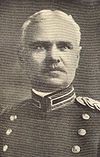
- George Washington Goethals, class of 1880
- Maj. Gen. John Wilson Ruckman, class of 1883
- General of the Armies John J. Pershing, class of 1886
- General Peyton C. March, class of 1888
- General John L. Hines, class of 1891
- General Charles Pelot Summerall, class of 1892
- Maj. Gen. Fox Conner, class of 1898
- Robert E. Wood, class of 1900
- Thomas Selfridge, class of 1903; the first person to die in a crash of a powered airplane
- Gen. Lesley J. McNair, class of 1904
- Gen. Joseph W. "Vinegar Joe" Stilwell, class of 1904
- Gen. Jonathan Mayhew Wainwright IV, class of 1906
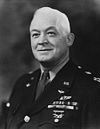
- General of the Air Force Henry "Hap" Arnold, class of 1907
- Lt. Gen. Simon Bolivar Buckner Jr., class of 1908
- Gen. Jacob L. Devers, class of 1909
- Gen. Robert L. Eichelberger, class of 1909
- Gen. George S. Patton, class of 1909
- Lt. Gen. William Hood Simpson, class of 1909
- Gen. Wade H. Haislip, class of 1912
- Lt. Gen. Walton Walker, class of 1912
- Gen. Alexander Patch, class of 1913
- Maj. Gen Junius Wallace Jones, class of 1913
- Brig. Gen. Vicente Lim, class of 1914
- Gen. Brehon B. Somervell, class of 1914
- Gen. Carl Andrew Spaatz, class of 1914
- General of the Army Omar Bradley, class of 1915
- General of the Army Dwight Eisenhower, class of 1915
- Gen. Hubert Harmon, class of 1915
- Gen. Joseph T. McNarney, class of 1915
- Lt. Gen. George E. Stratemeyer, class of 1915
- Gen. James Van Fleet, class of 1915
- Gen. Robert Neyland, class of 1916
- Gen. Mark W. Clark, class of 1917
- Gen. J. Lawton Collins, class of 1917
- Maj. Gen. Norman Cota, class of 1917
- Maj. Gen. Ernest N. Harmon, class of 1917
- Gen. Matthew B. Ridgway, class of 1917
- Maj. Gen. Norman Schwarzkopf Sr., class of 1917
- Gen. Lucius D. Clay, class of June 1918
- Lt. Gen Leslie Groves, class of November 1918
- Gen. Alfred Gruenther, class of 1919
- Gen. Anthony McAuliffe, class of 1919
- Gen. Williston B. Palmer, class of 1919
- Earl Blaik, class of 1920
- Gen. Maxwell D. Taylor, class of 1922
- Col. Mickey Marcus, class of 1924
- Gen. James Edward Moore, class of 1924
- Lt. Gen. James M. Gavin, class of 1929
- Gen. Harold K. Johnson, class of 1933
- Lt. Gen. Leighton I. Davis, class of 1935
- Gen. Creighton Abrams, class of 1936
- Lt. Gen. Benjamin O. Davis Jr., class of 1936
- Gen. William Westmoreland, class of 1936
- Gen. Rafael Ileto, class of 1943
- Gen. Bernard W. Rogers, class of 1943
- Gen. Anastasio Somoza Debayle, class of 1946
- Col. Thomas L. Gatch Jr., class of 1946
- Gov. Warren E. Hearnes, class of 1946
- Lt. Gen. Brent Scowcroft, class of 1947
- Gen. Alexander Haig, class of 1947
- Col. Frank Borman, class of 1950
- Gen. Fidel V. Ramos, class of 1950
- Col. Buzz Aldrin, class of 1951
- Gen. Roscoe Robinson Jr., class of 1951
- Michael Collins, class of 1952
- Lt. Col. Ed White, class of 1952
- Gen. Norman Schwarzkopf Jr., class of 1956
- John Block, class of 1957
- Brig. Gen. Pete Dawkins, class of 1959
- Col. Jim Nicholson, class of 1961
- Maj. James Kimsey, class of 1962
- Gen. George A. Fisher Jr., class of 1964, commander of Multi-National Force – Haiti during Operation Uphold Democracy (1995)
- Gen. Barry McCaffrey, class of 1964
- Gen. Eric K. Shinseki, class of 1965
- Gen. Wesley Clark, class of 1966
- Brig. Gen. Thomas E. White, class of 1967
- Maj. Gen. Albert Madora, class of 1968 [365]
- Capt. Mike Krzyzewski, class of 1969
- Capt. Roy Moore, class of 1969
- Brig. Gen. Patrick Finnegan, class of 1971
- Capt. Jack Reed, class of 1971
- Gen. Richard A. Cody, class of 1972, U.S. Army Vice Chief of Staff (2004-2008)
- Col. William S. McArthur, class of 1973
- Gen. Keith B. Alexander, class of 1974
- Gen. Martin Dempsey, class of 1974
- Gen. David Petraeus, class of 1974
- Gen. Walter L. Sharp, class of 1974
- Capt. Louis Caldera, class of 1978
- Gen. John F. Campbell, class of 1979, U.S. Army Vice Chief of Staff (2013-2014)
- José María Figueres, class of 1979
- Col. Robert L. Gordon III, class of 1979
- Maj. Gen. Gregg F. Martin, class of 1979
- Gen. Daniel B. Allyn, class of 1981, U.S. Army Vice Chief of Staff (2014-2017)
- Capt. Geoff Davis, class of 1981
- Maj. Gen. Nadja West, class of 1982, the first black Army Surgeon General, the first black female active-duty major general, and the first black female major general in Army medicine
- Gen. Joseph M. Martin, class of 1986, U.S. Army Vice Chief of Staff (2019–2022)
- Maj. Gen. Diana M. Holland, class of 1990; the first female commandant of cadets at West Point; first female deputy commanding general of a light infantry division; first woman promoted to Maj. Gen. in the active component of the Army's engineer branch
- Lt. Col Jen Easterly, class of 1990; director of Cybersecurity and Infrastructure Security Agency under the Biden Administration
- Gen. Hun Manet, class of 1999; the first Cambodian graduate; Prime Minister of Cambodia (2023–present); former deputy commander-in-chief of the Royal Cambodian Armed Forces
- Lt. Dan Choi, class of 2003; founding member and spokesperson of Knights Out, an organization of West Point alumni who support the rights of LGBT soldiers to serve openly
- Capt. Alejandro Villanueva, class of 2010; football offensive tackle for the Pittsburgh Steelers in the National Football League
- Lt. Josh McNary, class of 2011; football linebacker for the Indianapolis Colts in the National Football League
- Gen. Randy A. George, class of 1988, U.S. Army Vice Chief of Staff (2022–present)
Non-graduates
- As these alumni did not graduate, their class year represents the year they would have graduated if they had completed their education at the Academy.
| 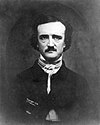 |
References
- General references
a: Special Collections: Biographical Register of the Officers and Graduates of the U. S. Military Academy. West Point, NY: United States Military Academy Library. 1950.
b: "Civil War Generals from West Point". University of Tennessee – Knoxville. 2003. Archived from the original on 5 June 2009. Retrieved 28 June 2009.
- Inline citations
External links
- Notable alumni Archived 18 May 2009 at the Wayback Machine from the United States Military Academy
- Famous graduates
- West Pointers on stamps
- History of the Army Olympians
- Mexican War and After from American Military History Archived 20 January 2020 at the Wayback Machine a publication of the United States Army Center of Military History
- West Point in the Making of America
- West Point Fact Sheet Archived 20 March 2012 at the Wayback Machine
- List of Commanders of the Royal Thai Armed Forces Headquarters
